Not long ago, the information and entertainment industry was dominated by a few big players. TV, radio, and newspaper were the major mediums used by most people to consume content.
But as the internet evolved, so did Web 2.0 – the web where users were not just consumers, but creators. People started creating content and sharing it with their communities. Individuals became the producers and their own brand managers.
This trend caused a revolution in the way content was produced, distributed, and consumed. And all this led to the development of the creator economy.
The creator economy can change in a matter of minutes. Now content creators need to be informed about the recent updates and changes in the market to continue to be successful.
So, beware of the latest trends of 2022 and adapt your content to keep getting revenue as a creator. But first, let us go back to the basics.
What is Creator Economy?
The creator economy is an economic system where creators turn content into a paid product or service. With the help of social media and various tools, creators can turn their knowledge into profit and sell it to anyone in the world from the comfort of their homes. These content creators are connected to their audiences and businesses via the internet.
With more than 50 million independent content creators, curators, and community builders fueling this new economic system, this generation is currently valued at $20 billion. In this system, creators have full autonomy over how they monetize their content. This new ownership is a great power shift in the employer-employee dynamic.
In the past, the power resided entirely in the hands of the employer. Now, individuals hold onto the power to own, govern, and make a profit from their work.
Who can be a creator?
While everyone has a different definition of the term “creator,” we are all creators. Technology and social platforms have transformed creators and experiences to connect with fans. Anyone able to create fans around their work is the most basic definition of a creator. A fandom could be a family, a single class, or 20k+ people who follow and support a creator financially.
Where is the Creator Economy going in 2022?
There are more than 50 million creators, and they are all truly diverse. Today you can find a creator for every topic. That makes calculating trends for the creator economy hard. So, we made the best effort to make the best summary of the trends we might be seeing for the last semester of 2022.

Brands as creators
Businesses understand that creating content is not limited to content creators. As we said, everyone can be a creator. They are equally responsible for making out great content to keep their audiences engaged. They know that they are as timely and fresh as their content is, and that they will only stay on top of customers’ minds by constantly appearing on their social feeds.
Brands like Nike are already doing great at content creation. They consistently publish content, jumping on current trends and talking about complicated subjects. Focusing on its athletes and sports teams instead of the product itself, Nike has drawn its audience’s attention to the people who make the brand. They focus on creating content more than selling their products.
Tip: If you have a brand or a business on social media, create more content with value. Tell stories, and make your followers feel something. This way engagement will go up and so will your sales.
Gen-Z driven
The creator economy will be driven by Gen-Zers, who will redefine small-to-medium businesses. It is noteworthy that Gen-Z builds businesses in a highly non-conventional manner. The fundamental difference is that they rely on a decentralized team to get the work done, as they work remotely.
Additionally, there are differences in terms of team composition and revenue models. While the teams are fluid and often temporal, the revenue model is community-driven.
Tip: Investigate how Gen-Zers create communities on social media. Adapt your strategy to what is working for them. It will work for you too!
Way more brand collaboration opportunities
As we said, bands are more interested in creating content instead of only promoting their products. That means they are willing to increase their investment in creator marketing.
Brands are open to spending millions because creators have a stronger bond with their target audience. They bridge the gap between brands and their customers. Therefore, they can compel them to purchase specific products. This immensely helps brands gain a leg up in social commerce. In addition, creators expand a brand’s awareness and reach, leading to increased conversion rates.
Tip: Look for creators that align their values with your business. And check the engagement they have on their social media profiles. And when you find the right match, be sure to have the correct contract to proceed with the partnership. For this case, you can use the Influencer Management contract just for $19!
Stories lead the way
Be it Facebook, Instagram, or TikTok; popular social media channels have added a new feature: Stories. Stories will play a crucial role in the coming months, so make sure you make the most of them. These 24-hour long clips quickly capture attention as they are placed right on top of the apps. Many additional features, including polls and votes, solicit the audience’s opinions to boost engagement.
These Stories have redefined audience engagement, forcing brands and creators to rethink how they find and engage with the audience. There are even third-party apps you can use to boost the curb appeal of your Stories.
Tip: As we know you have your social media calendar for posts, Reels, and TikTok, make sure to make one calendar only focusing on stories. This way you can take the time and plan a good strategy for the stories.
Fitness apps
Homegrown health and fitness apps have seen a recent spike in popularity with greater appeal to different, savvier audiences. The idea that “fitness can be anywhere” is now part of popular consumer culture as more app creators have found ways to reach a wider at-home fitness enthusiast range.
In 2022, instructors will be able to provide more snackable workouts that can be done in 10-15 minutes or less. And now that more people are working from home, they are more likely to use these apps instead of going to a gym.
Tip: If your business has anything to do with fitness, try to collaborate with these apps. They surely will have the target audience you are looking for. By collaborating with them, you may find lots of new clients. And, very importantly, when getting ready to collab, always have at hand the Brand Ambassador Contract to always protect your content!
Unquestionably, the creator economy growth shows an upward trend! Follow these tips and see how your content reaches more people than ever! And remember, always have a contract when you make any collaboration. They can be used in the negotiating process to ensure that both parties get the best deal possible.
How Creators’ Legal can help:
Creators Legal is an all-in-one contract platform that enables you to get contracts in minutes without any legal counsel, and you can also organize all your contracts in a single place. Our platform offers comprehensive, simple, straightforward, and trustworthy contracts in a fast, easy-to-use platform.
All our contracts are written by content production industry professionals with years of expertise. Plus, a robust form builder, a secure e-signature system, and a personalized dashboard where you can save and organize all your contracts are also available.
Related:
Why Do Creators Need Contracts?






